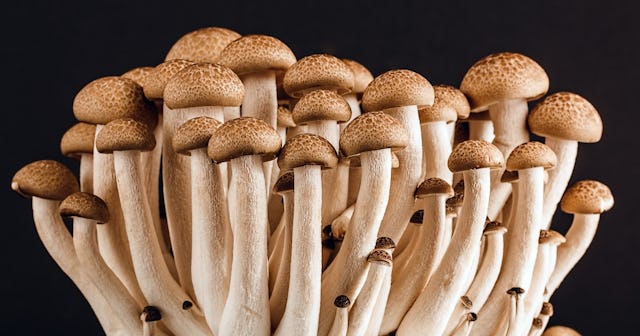What to Know About Microdosing Magic Mushrooms As A Treatment For PTSD

It’s strange to think about how some of the drugs you got in trouble for trying (or wanting to try) in high school are now being used for medical purposes, albeit in much smaller doses. This practice of taking minimal amounts of a psychedelic substance — not enough to cause hallucinations — is called microdosing. One of the most popular forms of this practice is microdosing mushrooms containing psilocybin. What is that, you ask? Well, it’s a psychedelic substance and what puts the “magic” in “magic mushrooms.”
While clinical research on microdosing mushrooms is still pretty new, a primary focal point has been using it to treat post-traumatic stress disorder (PTSD). Here’s what to know about this practice, including the potential risks and benefits of using it in treating mental illnesses.
What are the benefits of microdosing mushrooms?
Although the use of psychedelics like magic mushrooms is often characterized as “substance abuse,” some research indicates that it has therapeutic properties. The aim of microdosing? To allow people to reap the benefits of these drugs without dealing with the negative effects and potential harms of taking a full dose.
Determining any substantial medical or health benefits of microdosing mushrooms requires further research, including randomized controlled trials. But what we do have at this point is some observational trials, where people who have experience microdosing mushrooms answer questions and describe their experiences. In one such study, published in 2018, participants reported that microdosing resulted in them being in a better mood, feeling more creative, and experiencing better focus. The participants also noted that microdosing mushrooms often helped symptoms associated with anxiety and depression. This drug can be a big help to people with an array of issues like:
- Asperger’s syndrome
- Bipolar disorder
- Learning disabilities
- Migraines
- Obsessive-compulsive disorder (OCD)
- Procrastination
- Problem-solving
- Psychotherapy
- Recovery from addiction
- Stuttering
- Trauma
How could microdosing mushrooms be used to treat PTSD?
One of the most talked-about uses for microdosing mushrooms has been to treat PTSD. In an interview with The Healthy, Dr. Matthew Johnson — associate professor of psychiatry at the Johns Hopkins University School of Medicine, a principal investigator of multiple psychedelic research studies, and an expert on addiction and risk behavior — described why this practice is being explored as a potential treatment for PTSD.
Because of their past trauma, people with PTSD can cause problems with trust, closeness, communication — something Johnson says makes it difficult for them to get the extent of the help they need in traditional talk therapy. And it just so happens that psilocybin, the psychedelic substance in magic mushrooms, affects neurotransmitters and evokes feelings of trust. So, Johnson says, the idea here is to use microdoses of mushrooms to allow someone with PTSD to fully open up (and be open to help) during a therapy session.
In addition to facilitating a better rapport with therapists, microdosing mushrooms can also put a damper on the emotional response a person has to the source of their trauma. This allows them to confront their trauma without being triggered by it, Johnson explains. This practice can also increase a person’s self-empathy and self-compassion — which can further aid in the healing process.
How long does a shroom trip last?
When taking a psychedelic, it’s important to know how long the trip can last. Trip is a term used to describe the experience of a hallucinogenic drug. It can last anywhere between four to six hours but could take longer or even all day. The length of the trip depends on how much you ingest, the mushroom species, whether it’s dried or fresh (dry ones are more potent), your age, and tolerance. When taking shrooms, it can take about 30 minutes to hit your system. But shroom tea can kick in as fast as five to 10 minutes after drinking it.
Keep in mind, mushrooms can hinder or warp your perception of reality, so stay in a space you feel comfortable and safe. Do not operate heavy machinery or drive as you can be a danger to yourself and others.
How to Prepare for a Shroom Trip
Shrooms can be a life changing experience, but safety is key. So before partaking in this psychedelic, prepare for this experience properly by following these tips below. This advice is mainly for first-timers.
- Shrooms are a truly mental experience, so it’s important to be in a positive headspace before indulging. It can trigger psychotic episodes, so meditate and destress beforehand to avoid a bad trip or harming your mental state.
- Use the buddy system. Have a person in the room who isn’t indulging. These people are called sober sitters. They’re there to watch you and keep you safe as you trip.
- Choose the proper setting and people. Never do psychedelics or any drug in a space where you feel uncomfortable. Make sure you have people around you who you trust and are in a place where you feel OK. The wrong situation can ruin your trip.
- On your shroom trip, avoid taking any physical trips. It’s best to stay in one place. Do not drive or travel, especially if it’s your first time. Tripping can distort color, including traffic lights, so it’s best to keep your body parked.
- Remove mirrors. When you’re in the shroom zone, your body, specifically your skin, can become very interesting. It can either keep you entertained for hours or freak you TF out. Play it safe and keep the mirrors covered until after your trip.
This article was originally published on